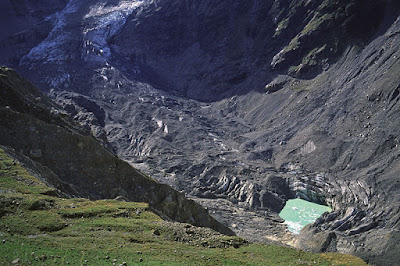Unterer Grindelwaldgletscher in the Alps. Debris-covered snout with many additions coming from valley side rockfalls
Chukhung Glacier, Nepal
Erratic Valley, Antarctic Peninsula. Exposure of surface till in an area of hummocky moraine
Crusoe Glacier snout, Axel Heiberg Island. Bedrock exposures adding rockfall debris to mixed morainic and fluvioglacial materials
Khumbu Glacier, Nepal. Ice-cored moraines
Fox Glacier, New Zealand
Rohn Glacier, Alaska. Dead ice terrain on the glacier flank, with meltwater lakes

Bing satellite image of the terminal moraine loop and dead ice terrain, Roslin Gletscher, East Greenland. In 1962 we walked across that little lot -- it was a bit hairy at times.......

High-resolution Google Earth image of part of the same dead ice topography. The glacier snout is just off the photo at top left. Some of the trapped lakes are fed by debris-rich meltwater streams (buff colour) and others are isolated (blue).

Bing satellite image of the terminal moraine loop and dead ice terrain, Roslin Gletscher, East Greenland. In 1962 we walked across that little lot -- it was a bit hairy at times.......

High-resolution Google Earth image of part of the same dead ice topography. The glacier snout is just off the photo at top left. Some of the trapped lakes are fed by debris-rich meltwater streams (buff colour) and others are isolated (blue).







3 comments:
What is dead ice? Ice that is decayed or not moving?
Seems to be too simple a question to ask.
Dave
Yes, exactly that, Dave. Sometimes called "stagnant ice" in texts. It may still be connected to the glacier, but very often it is detached -- as a glacier decays it tends to break up into isolated bits and pieces by concentrated melting processes -- sometimes along the routes of meltwater streams. Sometimes dead ice masses can be thickly buried beneath meltout till and flow till, and can last for thousands of years if the insulating till layer is thick enough. Walking across a terminal or lateral moraine area where there is dead ice can be very dangerous -- you never know when a slope is going to give way because the contact between the till and the ice mass is often well lubricated by a thin layer of meltwater. Several people have been killed in recent years -- in spite of ropes and warnings -- in the dead ice zone of the Cook Glacier of New Zealand. Been there myself -- it's lethal.
Sorry -- I meant Tasman Glacier, very close to Mount Cook Village. Far too accessible to hordes of tourists, who do not realise the dangers. Another post coming........
Post a Comment